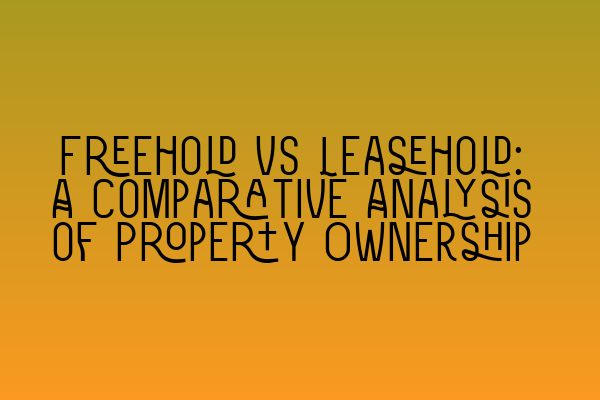Freehold vs Leasehold: A Comparative Analysis of Property Ownership
When it comes to property ownership, there are two main types that individuals encounter: freehold and leasehold. Understanding the differences between these two forms of ownership is crucial, whether you’re buying a new property, investing in real estate, or simply looking to expand your knowledge of property law.
In this article, we will delve into the nuances of freehold and leasehold ownership, analyzing their unique characteristics, advantages, and potential pitfalls. By the end of this comparative analysis, you’ll have a clear understanding of these property ownership types and be better equipped to make informed decisions in the realm of real estate.
Freehold Ownership: The Ultimate Ownership
Let’s begin by exploring freehold ownership, often regarded as the ultimate form of property ownership. In simple terms, owning a freehold property means having absolute ownership over both the property itself and the land it stands on. This gives the freeholder unlimited rights and full control over their property.
One of the key benefits of freehold ownership is the lack of time restrictions. Freehold properties can be owned indefinitely, allowing owners to enjoy a sense of permanence and stability. Furthermore, as a freeholder, you have the freedom to modify, alter, or even demolish the property (subject to planning permissions and local regulations) without seeking permission from any external entity.
Additionally, freehold ownership removes the need for ground rent payments, as there’s no superior landlord involved. This results in potentially significant cost savings over time, providing a more financially secure investment in the long run.
However, it’s important to note that freehold ownership also carries responsibilities. As a freeholder, you are solely responsible for the maintenance and repair of the property and any associated costs. This includes the upkeep of communal areas if applicable, which can be a consideration when purchasing a freehold property in a development or estate.
Leasehold Ownership: Understanding the Terms
Leasehold ownership, on the other hand, grants the right to occupy and use a property for a fixed period of time, as specified in a lease agreement. In this arrangement, the freehold remains with the landlord, who grants a lease to the leaseholder for a predetermined timeframe, typically decades.
One of the significant distinctions between freehold and leasehold ownership is the time limitation. Leasehold properties have an expiration date, and once the lease term ends, the ownership of the property reverts back to the freeholder. This can create uncertainty for leaseholders, especially if the lease term is shorter or nearing expiration.
Despite the limited tenure, leasehold properties can offer various advantages to both buyers and investors. For instance, leasehold ownership is commonly associated with flats and apartments, which often provide desirable locations and amenities. Additionally, leasehold properties may come with shared spaces and facilities, such as gardens, gyms, and parking areas, typically maintained and managed by the freeholder or a management company.
Moreover, leasehold ownership can provide a degree of affordability, as the initial purchase price is often lower than that of a freehold property. This makes leasehold properties accessible to a wider range of buyers, particularly those looking to enter the real estate market or invest in a rental property.
However, leasehold ownership is not without its complexities and potential drawbacks. Leaseholders are typically required to pay ground rent to the freeholder, as well as service charges for the maintenance and upkeep of communal areas. These ongoing expenses can increase over time and may require budgeting and careful consideration.
Additionally, leaseholders may face restrictions in terms of property alterations and renovations, as they need to obtain consent from the freeholder or abide by certain lease conditions. It’s essential for leaseholders to review the lease agreement thoroughly to fully understand their rights and obligations.
Making an Informed Decision
When deciding between freehold and leasehold ownership, it’s crucial to consider your personal circumstances, financial position, and future plans. Each type of ownership offers unique benefits and considerations, and what works for one individual may not be the best choice for another.
To help you make an informed decision, it’s advisable to seek expert legal advice from a solicitor specializing in property law. They will thoroughly review the terms and conditions of each ownership type, ensuring you fully understand the implications and obligations associated with your chosen property.
At SQE Property Law & Land Law, we provide expert guidance and support to help you navigate the complexities of property ownership. Our experienced solicitors can assist you in understanding the intricacies of freehold and leasehold ownership, ensuring you make the right choice that aligns with your goals and aspirations.
For more information on property law and preparing for the Solicitors Qualifying Examination (SQE), be sure to check out our related articles:
– SQE 1 Practice Exam Questions
– SQE 1 Practice Mocks FLK1 FLK2
– SQE 2 Preparation Courses
– SQE 1 Preparation Courses
– SRA SQE Exam Dates
Contact SQE Property Law & Land Law today to schedule a consultation with one of our experienced solicitors. We’re here to guide you through the intricacies of property ownership and ensure you have a smooth and successful experience in the real estate market.
